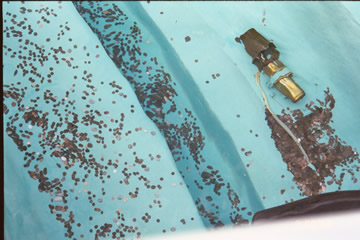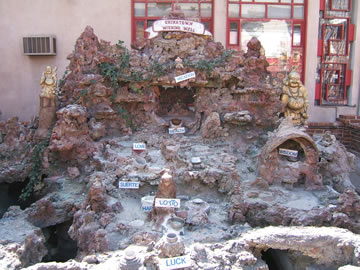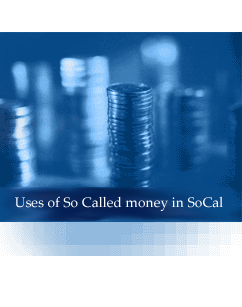 |
 |
||
|
|
Wishing WellsThe practice of buying good fortune.by Lauren Tabila, James Green, Jonathan Kwok, Kara Thurn, Meagan McLaughlin Fountains and ponds have become common choices of decoration to complement architecture or places that invoke an atmosphere of leisure. While walking in a park, a person might hear the refreshing sounds of running water, and approach a fountain to find glistening tokens covering the surface beneath the water. It is almost impossible now, to find a fountain, well, or pond without coins on the bottom. Virtually any pool made accessible to the public qualifies as a wishing well. The coins found in wishing wells are vestiges of the desires of patrons who can only hope that their wishes may come true. Wishes can be vague or general fortunes such as happiness, wealth, and love. They may also be extremely personal desires, such as an intimate request for a loved one to recover from illness. Thus, throwing a coin into a volume of water while making a wish has become a common practice in Southern California culture. Although the exact origins of this practice are unknown, offering money to water is an old tradition that can be dated back to Roman-British and Celtic mythology. Since then, the tradition of making a wish with a coin has been passed down through generations by socialization, evolving from a religious ritual into a fun, yet superstitious, cultural practice in Southern California. Furthermore, this practice of wishing with coins at a well tests the Western sense of rationality and cannot be explained by categorizing Southern Californians as rational economic actors; this definition does not fit in with the actions we observed while conducting our research. What was witnessed during our fieldwork can be most effectively explained by relationships with the supernatural, earmarking of monetary objects, and other, not entirely "rational" practices. An example of a historical wishing well could be found in the county of Northumberland, located in the northeastern tip of England, which has a very famous well that was used to make offerings to the Roman Britain and Celtic goddess Coventina. The archeological discovery of Coventina’s Well unearthed thousands of coins from different eras of the Roman Empire. About 16,000 coins in all were discovered in this well, including coins issued between the first and fifth centuries (Aitchison, 1988, p. 274-275). The great range of coinage implies that people have been adding coins to the well for many generations. Because the well was found among temple remains, the coins were believed to be religious offerings made to the goddess Coventina. Aitchison points out, however, that most of the coins found in Coventina’s Well were “low denomination bronze issues” (1988, p 275). People who offered coins to the well chose coins that were either worth very little or nothing at all. This suggests that the economic exchange value of the coin is not equal to the value the coin had as a gift to a divine power. Since then, much of the history of wishing wells has been forgotten, making people unaware of the origins or purpose of the very practice they keep alive. A number of interviews were conducted in three various locations in Southern California in order to study people’s understandings of wishing well practices. Generally, people did not know where the practice came from but in some cases were taught about wishing wells from their parents, from movies, or by imitation. For example, a woman in an interview remembered that she was taught by her mother to throw coins into fountains as a child. In other cases, however, people could not remember how they learned to wish with coins, but knew that their parents did not teach them the practice. The wishing well concept also permeates society through repeated exposure in media and public venues. In one interview, a couple referred to the popular Disney movie Snow White, since the movie included a scene with the main character wishing beside a well. Seeing the practice in a movie or watching other people make wishes by wishing wells causes other people to take part in the practice as well. Similar to old traditions of wishing wells, the broad belief of a higher power is a concept that has been carried into present Southern California wishing well practices. Though people are usually unaware of the reasons why they make wishes in wishing wells, the practice may be interpreted as a form of supernatural investment in which present offering will be repaid later at appropriate and fortuitous occasions. Wishing wells are cultural expressions of a belief in magic and the ability to control fate through the supernatural. This notion is predicated on the idea that the “outcome of events and objects are influenced by various thoughts (e.g. wishes) and interactions with the physical environment” (Vikan & Clausen, 1993, p. 298). One might feel that it is more probable for something favorable to happen if he or she actually makes a wish by throwing a coin into the well. Also, many people make wishes for the enjoyment of possibility. The act of tossing coins in wishing wells extends beyond its entertainment value to encompass a subtle and sophisticated doctrine of superstition. Although these expressions may be from the older traditions of wishing wells, these acts should in no way be considered wasteful, primitive, or inane. Rather, wishing wells are a method through which people exercise hope, especially against events whose desired outcomes are unlikely or uncertain (Averill & Sundararajan, 2005). The ability to hope is a hallmark of a healthy personality because it allows individuals to reconcile the opposing forces of reality and want. Hope also creates unique identities and personal histories by defining life through experiences of triumph and failure (Elster, 1985). In the case for wishing wells, hope is expressed by offering money. Money is not an empirical object of monetary value, but a medium instilled with systems of meanings and symbols. It can be apportioned for use with significant social relevance and minimal economic consequence. For example, a number of people recently interviewed believed that it does not matter whether a penny or a quarter is used to make a wish. Similar to the old practices of Coventina’s Well, people are not investing much money into their wishes (observed by low denomination coins in the well) because they did not believe that the economic value is as relevant as the symbolic value of their offering. People exchange money for wishes because they believe that such an action gives them some control over their lives amidst the myriad infinity of things that may happen. While some people may believe that the value of money used is insignificant, there are people in Southern California who stated in interviews that they do believe that wishes are more likely to come true if a greater value is offered. When used for wishing, money may operate on an incremental scale of valuation. However, the greater tribute is measured in relative terms, not absolute terms. Throwing in a quarter increases the likelihood of a wish coming true than compared to throwing in a penny, but not necessarily with a twenty-five times higher rate of success. In addition, giving a dollar coin is a particularly powerful gesture, though not simply because of its greater relative value. A dollar represents an offering that is considered somehow whole or complete. It is not a fraction or partial sum. Certain amounts of money rank individuals based on their contributions. Those who throw more are more deserving; thus, it will be more likely for their wish to be answered. This cultural practice runs contrary to the traditional notion that money functions in a steadfast, homogenizing, and rational manner. Money, this instance is evaluated qualitatively, not just quantitatively. The relationship that people engage in upon throwing coins in a wishing well to make a wish is similar beliefs of the Avgai-Khad in the post-Soviet Union. As previously discussed in class, here, local people in a city in post-communist Mongolia engage in a reciprocal, gift-giving relationship with omnipotent Nature by placing items of value in front of a rock formation named Avgai Khad. It is important to note that in this situation, the people are “reconstituting nature (giving gifts to Avgai Khad) … with the idea that the personification of nature will enable them to live successfully” (Humphrey, 2002, p.162). This explicit behavior of a group of peasants in Mongolia can be used to help explain and understand the behavior of people in Southern California. Although there are important differences between the case of Avgai Khad from Mongolia and the wishing wells here in Southern California, there are also similarities. One obvious difference between the two locations is that in Southern California, there is no specific wishing well where people throw coins in. There are wishing wells all over. Even wells not specifically marked as wishing wells find themselves brimming with coins from hopeful wishers (often against the well owner’s wishes and to the detriment of animal and plant life inhabiting the well). [PICTURE WILL BE INSERTED HERE] On the other hand, Avgai Khad is a specific monument people pay their tribute to. If the Mongolian peasants were to place their valuables in front of another rock formation, to them, it would not constitute engagement in the reciprocal relationship with nature; only valuables placed at the foot of Avgai Khad become immersed into the relationship. Another difference is that, unlike the relationship with nature formed by the Mongolian peasants, the relationship formed by residents in Southern California with whatever omnipotent power granting their wish is not explicitly understood. However, though this relationship may not be explicitly understood or thought to be as obvious as the relationship peasants have with nature through the use of Avgai Khad, the act of throwing coins into a wishing well in Southern California can implicitly be thought of as a entering a similar type of reciprocal relationship. First, people throwing coins into wishing wells often classify their actions as trivial or just for fun. Most expressed that they were just following a tradition. Nevertheless, people in Southern California still followed careful procedures when engaging in the act of throwing coins into a wishing well. Everyone threw coins into the well in order to make a wish. No one would simply stand at the well and wish, an offering of coins must be made. Furthermore, people were not wishing to the actual fountain, instead some higher power was thought to grant the wishes. Therefore, the fountain was merely a tool with which to make their wish; a type of medium used to express their wish to some other power or force. Lastly, though most brushed off the act as trivial, they would not reveal their wish to the interviewers or their family members because if it were known to others the wish would not come true. The implicit reciprocal relationship the residents of Southern California engaged in is revealed through their use of something of value to make their wish with. Although some Southern Californians believed that the amount of money thrown in did not matter, throwing trash, rocks, or nothing into the well would not result in a wish being granted. In an interview, a boy was observed tossing in a pebble into a fountain for fun, but he did not believe that his wish would not come true. Instead, something of value must be offered in exchange for one’s wish to come true. The boy’s mother had instructed him not to throw pebbles into the fountain but was willing to give coins to throw in instead. The fact that most of the residents of Southern California would not acknowledge their actions as being part of a reciprocal relationship, leads us to classify the understanding as implicit. Regardless of outward recognition of the relationship, the residents’ actions can still be understood this way. A present of value is offered through use of the wishing well in order to obtain granted wish from some higher source. Related back to the situation of the Mongolian peasants with Avgai Khad: where gifts of value being offered through the use of a rock formation in order to appease nature and receive favors, good luck, or granted wishes are similar. The similarity of these two practices leads one to perceive the actions of the Southern California residents in a different light. While the value of the coin encompasses a relationship with a higher power, the intrinsic worth still remains, especially for the owner of the well, pond or fountain. Once thrown into the well and the wisher departs, the coins used to make the wish reclaims monetary exchange value. The money can be appraised simultaneously as a fixed denomination of currency as well as a good proffered in exorbitant amounts (Guyer, 2004). Wishing well money retains its monetary value even after cast—the fact that the coin was tossed into the water does not change its intrinsic worth. Ten dollars of wishing well money still purchases only ten dollars worth of exchanged goods or services. When a well or fountain is cleaned, the coins at the bottom are also collected. This is how wishing wells constitute a form of spatial earmarking. Spatial earmarking is the practice by which money is segregated for specific purposes (Zelizer, 1997). Such money is usually placed within different containers so that it can be easily identified and not accidentally spent for other, more frivolous purposes. Money thrown into wishing wells becomes earmarked once it is intentionally tossed into the wells’ waters. Well owners later collect the money and usually appropriate it to charity. For example, one woman that was interviewed even stated that she was aware that she was funding a specific fund while allowing her child to throw money into the fountain. With so much symbolism and superstition embodied in wishing well practices, the actions of Southern Californians lead us to pose the question: “is this ‘rational’”? In the Western, capitalistic economic climate of Southern California, money is thought to be completely fungible, convertible into other units. It is also thought that money is “infinite[ly] flexible and divisible” (Simmel, 1907, p.297). However, the money used in the act of wishing at a well does not fit in with these definitions of “fungibility.” It is not completely flexible or divisible and appears to have gained a new type of meaning or status in the eyes of both those making the wish and those witnessing the act. This leads us back to our question of whether this act is “rational” in our understandings of the word. In our capitalist society, economists would predict that Southern Californians should be rational economic actors. This definition would not include them engaging in a transaction where no tangible object is purchased (exchanging coins for the hopes of a wish coming true). This description of Southern Californians as rational economic actors would also not include the differentiation of money objects into separate status categories. However, this is exactly what has occurred here. The money from your wallet does not have the same status, nor carry the same connotations as the money in the well. The well money has attained a new status because of its use in a specific type of transaction. It seems to be elevated above money from your wallet; because of this it is not acceptable for the use in everyday transactions and is not completely flexible and divisible. From the many examples presented about wishing wells in Southern California and around the world, we have seen that the use of money is not completely "rational" in the Western sense of the world. Instead, money is, used to engage in relationships with the divine, earmarked, and given a different status depending on how it was used. Because of this, even in Southern California, one may find monetary practices that bewilder or challenge our conventional notions of the economy and money itself.
|
|
Dept. of Anthropology
University of California, Irvine
Irvine, CA 92697-5100
email wmmaurer at uci dot edu


